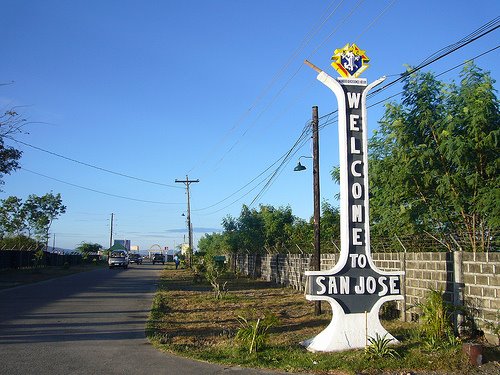In military parlance as well as in classic literature, this duel is called “single combat” but in politics and sports, it’s simply a “one-on-one” fight. In Homer’s epic poem Iliad for example, the duels between individual soldiers include those between Achilles and Hector.
Except for a few instances, it was usually a duel or face-off between two men. Opponents who are cream of the crop, the titleholders of their sides. It’s also a showdown between the Liberal Party (LP) of Josephine Ramirez-Sato and Eduardo B. Gadiano’s Pederalismo ng Dugong Dakilang Samahan (PDDS).
Again, adhering to the dictum “The heart and soul of elections is an informed electorate”, I am writing this second blog entry on Occidental Mindoro election aspirants. (Kindly click THIS to read the first part of the series.)
Born on April 1, 1963, Gov. Ed was raised by a poor but industrious family of farmers in Rang-Ayan (now Brgy. Pag-Asa, Sablayan). His father is Prudencio “Puding” L. Gadiano an Ilocano who served as Barrio Captain of the place and his mother is Corazon Lopez Baltazar of Nueva Ecija.
Cong. Nene, on the other hand, was born in San Jose, also in Occidental Mindoro on April 29, 1954, and daughter of Pacifica Ylagan and the educator Mariano C. Ramirez, San Jose East District Supervisor of the Department of Education back then.
Although both were born in April, his zodiac sign is Aries and she is Taurus. He is 58 while she is 67.
Unlike Gov. Eduardo Gadiano’s phenomenal victory against Mario Gene Mendiola in 2019, this is an inter-gender tussle, though it is not his first-ever. He won the Sablayan mayoralty seat against Edna Mintu, wife of the former mayor in 2010, who later became his political ally.
The Hebrew Bible also includes a few accounts of single combat, the famous being David against Goliath. When Gadiano won against a seasoned political titan Mendiola, he was considered by many political observers as a giant slayer like the biblical David or the children’s book character named Jack.
But in Japan’s 14th-century Japanese literature, a lady Samurai named Tomoe Gozen is highlighted as one who defeated men in various battles. She was a remarkable swordswoman and a warrior worth a thousand. She slaughtered a ferocious male Samurai named Uchida Ieyoshi who attacked Tomoe but she swung her katana and cut him to death.
Not unlike Tomoe Gozen, Cong. Josephine Ramirez-Sato used to figuratively slay a bunch of men since her political baptism decades of decades ago, from Atty. Emil Villamar, Gov. Peter Medalla to Cong. Jose Villarosa, Damsy Malabanan, Father Ronilo Omanio, including Mayor Juan Sanchez in 2019. Thus, Cong. Nene is used to winning in inter-gender matches in the past.
Now that the candidacy of Adrian Gatdula, the third gubernatorial aspirant, according to my source, hangs in a balance apparently due to SOCE issues, the head-on one-on-one clash between Sato and Gadiano is surefire. Their face-off is certain as the sun will rise tomorrow.
Lady’s first.
Undefeated
Josephine Y. Ramirez first ventured into politics when she served as vice-governor from 1988 to 1992 of Gov. Peter Medalla Jr. She first won as governor in 1992 dethroning Medalla, her former ally, and served until 2001. Jose T. Villarosa was governor from 2001 to 2004, then the lady lawyer regained the top executive political position from 2004 to 2013.
Before she entered politics in 1988, Ramirez (soon to be Sato) accomplished a program on Instructions of Lawyers-International Law and Taxation at Harvard University School of Law and in 1987 she completed her Urban Studies and Planning at Massachusetts Institute of Technology. Before that, she graduated with a political science degree from St Theresa’s College in 1973. She then attended the University of the Philippines College of Law, where she emerged among the top graduates of batch 1978.
Looking back, Sato was elected governor for three consecutive terms (1992–1995, 1995–1998, 1998–2001.) Then served her first term as congresswoman from 2001–2004. After Sato's first term as a congresswoman, she again served for three consecutive terms as governor of our beloved province (2004–2007, 2007–2010, 2010–2013). Then after her sixth term as governor, she has again elected as congresswoman of Occidental Mindoro, a seat she occupies to this very hour.
A report by certain Jan Escosio posted on INQUIRER.net last October 22, 2021, states, “Sato has been in public service for 33 years now, providing quality leadership rooted in experience, competence, dedication, compassion, and a sense of urgency to act in the best interest of the people of Occidental Mindoro.”
Sato holds the record of being the lone representative from the province who became a member of the powerful Commission on Appointments (CA) not just once but twice — in the 17th (2016-19) and the 18th (2019-present) Congress.
For three decades and three years now, she is generally considered the most powerful and accomplished lady politician in Occidental Mindoro’s history. She’s never been defeated and holds the record as the undisputed champion in his entire political career. In one of her campaign discourses in the past, she said that the one who will beat her has not yet been born.
Apparently, she has an unfinished business to settle.
Phenomenon
Eduardo B. Gadiano is the most accomplished politician yet, from Sablayan being voted to the position of a provincial governor. In the political history of Occidental Mindoro, he is the only politician from the ranks who was able to gain the gubernatorial post.
Indeed, he went down in the province’s history as the only barangay captain, and the only municipal councilor, and vice-mayor, as I have said, who eventually became governor. However, a feat that cannot be easily accomplished, especially nowadays, when political overstaying is rampant all over the country. It would probably take centuries before one could break such a feat.
He took up Bachelor of Science in Agricultural Engineering at Gregorio Araneta Foundation and Bachelor of Science in Industrial Management at the Pamantasan ng Lungsod ng Maynila.
Anybody who rigidly followed the political career of the province’s incumbent governor knows that he scaled the political ladder from the ranks and that makes him a political phenomenon. He was Punong Barangay in Brgy. Pag-Asa, Sablayan, his place of birth, from 1994-1998, then became the town’s municipal councilor from 1998-2001 and concluded his term. Next, he was elevated to vice-mayor, completing his full 3-year terms from 2001-2010. He was elected mayor, finishing his full three-year terms from 2010 to 2019.
Under Gadiano’s watch, Sablayan gained four Seal of Good Local Governance (SGLG) awards, a coveted national award bequeathed by no less than the Department of the Interior and Local Government or DILG. That was in 2011, 2015, 2017, and 2018, respectively. The DILG bestowed Sablayan’s fourth Seal of Local Good Governance in 2018 and just four other LGU-awardees in the MIMAROPA Region.
He believes that an elected official cannot unceasingly join the political fray forever. Gadiano is confident that politics cannot be bottomless as there is a limit to everything like the rubber band’s stretching ability. It is so fluid that anything could happen in the end.
From the looks of it, he wants to continue the change he has started after he took office barely three years ago.
Agriculture and Health
Our province has a land area of 5,851.09 square kilometers or 2,259.12 square miles. In the 2020 Census, it was determined that the population was 525,354. It comprises 11 municipalities and 164 villages or barangays. Let us just focus on these two major concerns: agriculture economy and community health. These two are the most important part of the political discussion involving the gubernatorial candidates as Election Day approaches, as far as this writer is concerned. Of course, one should not overlook other issues and concerns experienced by our people which were included by the politicians in their platforms.
Since Occidental Mindoro is an agricultural province majority involved in rice farming, the biggest black-eye confronting our farmers is the high cost of production due to escalation prices of farm inputs. Because of our deforested watersheds, shortage of irrigation became a nagging problem. Occidental Mindoro’s river systems are no longer capacitated to the needed volume of water to make irrigation possible. This situation is aggravated by the recent implementation of the Rice Tariffication Law by the national government. It is now progressively causing an increase in income poverty in the province according to the local farmer leaders themselves. Agriculture is still the provinces’ economic driver.
According to a study conducted in September 2014 by Rosa Mistica C. Ignacio, et. al, of Yonsei University, Wonju, Korea titled “Health Status of the Residents in Occidental Mindoro, Philippines: A Way to Make a Healthy Community”, Occidental Mindoro suffers from lack of health workers compared with the total population of each municipality. Not to mention the scarcity and the upgrading of medical facilities and equipment and other health necessities.
The study has this conclusion: “Socio-economic support will provide a good occupation or stable income to the villagers, which could meet the needs of each household, such as good education, healthy lifestyles, and good reproductive and environmental health. Health programs do not guarantee a healthy individual and a healthy society, but a combination of health programs and socioeconomic support can help in creating a healthy community.” And due to Mandanas Ruling which will initially be implemented next year, with additional revenues intended for LGUs, therefore, there is a dire need for a governor who is good in financial and human resource management.
By prioritizing agriculture economy and community health, social protection programs, employment diversification, and sustainable economic empowerment, sustainable and pro-poor tourism, infrastructure development, investment in agribusiness enterprises, nutrition and combating diseases, and disaster risk reduction and climate change adaptation by increasing resilience and decreasing vulnerabilities, to mention a few, would easily fall in its proper places.
It is imperative that these two concerns, among other things, should not be left out in the campaigns and should be our basis for whom to vote for governor come 2022. Weighing who among the two aspiring provincial heads has doable, practical, and responsive socio-economic support in the campaign promise or agenda with the people, is essential than cheap discussions stirred and fanned by gutless, passionate fandom opinions and rantings. People will also judge them both by the character of their propagandists.
This cannot be just a contest of commanding interests, personal, desperate, and cowardly attacks, sound bites, and social media hype.
We will not only vote for them
Understandably during elections, everyone and everything is so focused and so concentrated on how to vote and/or get votes for certain candidates. This gubernatorial election isn’t necessarily only about Sato and Gadiano. Voting is participatory governance at its best.
When we become more aware of the importance of one vote, we gain a better appreciation that all our votes are not for the politicians, but God and the country. We do not vote only for politicians. We vote for the province, for our people, those living today, and those who will come after us. Ergo, we will vote for our children and children’s children and of course, ourselves.
---
(Photo:
Gov. Ed Gadiano’s FB Page)







No comments:
Post a Comment